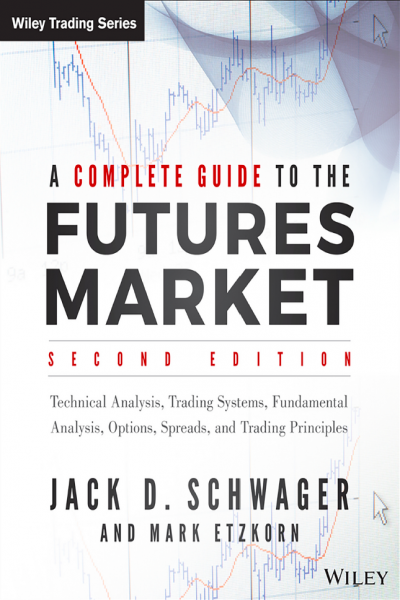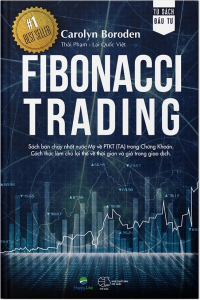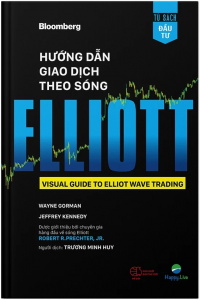A Complete Guide to the Futures Market
Technical Analysis and Trading Systems, Fundamental Analysis, Options, Spreads, and Trading Principles Second Edition. Jack D. Schwager & Mark Etzkorn.
Đặt in thành sách tại HoaXanh, xem sách in mẩu trong video bên dưới.
- 230,000đ
- Thương hiệu: Wiley
- Mã sản phẩm: A-C204858
- Tình trạng: 2
Part I Preliminaries
Chapter 1 For Beginners Only 3
Purpose of This Chapter 3
The Nature of Futures Markets 3
Delivery 4
Contract Specifications 5
Volume and Open Interest 9
Hedging 11
Trading 15
Types of Orders 16
Commissions and Margins 19
Tax Considerations 19
Chapter 2 The Great Fundamental versus Technical Analysis Debate 21
Part II Chart Analysis and Technical Indicators
Chapter 3 Charts: Forecasting Tool or Folklore? 27
Chapter 4 Types of Charts 35
Bar Charts 35
Linked Contract Series: Nearest Futures versus Continuous Futures 39
Close-Only (“Line”) Charts 40
Point-and-Figure Charts 42
Candlestick Charts 43
Chapter 5 Linking Contracts for Long-Term Chart Analysis:
Nearest versus Continuous Futures 45
The Necessity of Linked-Contract Charts 45
Methods of Creating Linked-Contract Charts 46
Nearest versus Continuous Futures in Chart Analysis 48
Conclusion 51
Chapter 6 Trends 57
Defining Trends by Highs and Lows 57
TD Lines 66
Internal Trend Lines 73
Moving Averages 78
Chapter 7 Trading Ranges 83
Trading Ranges: Trading Considerations 83
Trading Range Breakouts 86
Chapter 8 Support and Resistance 91
Nearest Futures or Continuous Futures? 91
Trading Ranges 92
Prior Major Highs and Lows 94
Concentrations of Relative Highs and Relative Lows 101
Trend Lines, Channels, and Internal Trend Lines 106
Price Envelope Bands 107
Chapter 9 Chart Patterns 109
One-Day Patterns 109
Continuation Patterns 122
Top and Bottom Formations 134
Chapter 10 Is Chart Analysis Still Valid? 149
Chapter 11 Technical Indicators 155
What Is an Indicator? 155
The Basic Indicator Calculations 157
Comparing Indicators 157
Moving Average Types 165
Oscillators and Trading Signals 167
Indicator Myths 170
Indicator “Types” 172
Conclusion
Part III Applying Chart Analysis to Trading
Chapter 12 Midtrend Entry and Pyramiding 177
Chapter 13 Choosing Stop-Loss Points 183
Chapter 14 Setting Objectives and Other Position Exit Criteria 189
Chart-Based Objectives 189
Measured Move 190
Rule of Seven 194
Support and Resistance Levels 196
Overbought/Oversold Indicators 198
DeMark Sequential 199
Contrary Opinion 203
Trailing Stops 204
Change of Market Opinion 204
Chapter 15 The Most Important Rule in Chart Analysis 205
Failed Signals 205
Bull and Bear Traps 205
False Trend Line Breakouts 211
Return to Spike Extremes 213
Return to Wide-Ranging Day Extremes 216
Counter-to-Anticipated Breakout of Flag or Pennant 219
Opposite Direction Breakout of Flag or Pennant Following a Normal Breakout 222
Penetration of Top and Bottom Formations 225
Breaking of Curvature 229
The Future Reliability of Failed Signals 229
Conclusion 231
Part IV T rading Systems and Performance Measurement
Chapter 16 Technical Trading Systems: Structure and Design 235
The Benefits of a Mechanical Trading System 236
Three Basic Types of Systems 236
Trend-Following Systems 237
Ten Common Problems with Standard Trend-Following Systems 244
Possible Modifications for Basic Trend-Following Systems 247
Countertrend Systems 254
Diversification 256
Ten Common Problems with Trend-Following Systems Revisited 259
Chapter 17 Examples of Original Trading Systems 261
Wide-Ranging-Day System 261
Run-Day Breakout System 268
Run-Day Consecutive Count System 273
Conclusion 278
Chapter 18 Selecting the Best Futures Price Series for System Testing 279
Actual Contract Series 279
Nearest Futures 280
Constant-Forward (“Perpetual”) Series 281
Continuous (Spread-Adjusted) Price Series 282
Comparing the Series 285
Conclusion 287
Chapter 19 Testing and Optimizing Trading Systems 289
The Well-Chosen Example 289
Basic Concepts and Definitions 291
Choosing the Price Series 293
Choosing the Time Period 293
Realistic Assumptions 295
Optimizing Systems 297
The Optimization Myth 298
Testing versus Fitting 310
The Truth about Simulated Results 312
Multimarket System Testing 313
Negative Results 314
Ten Steps in Constructing and Testing a Trading System 315
Observations about Trading Systems 316
Chapter 20 How to Evaluate Past Performance 319
Why Return Alone Is Meaningless 319
Risk-Adjusted Return Measures 323
Visual Performance Evaluation 335
Investment Insights 343
Part V Funda mental Analysis
Chapter 21 Fourteen Popular Fallacies, or What Not to Do Wrong 347
Five Short Scenes 347
The Fourteen Fallacies 349
Chapter 22 Supply-Demand Analysis: Basic Economic Theory 359
Supply and Demand Defined 359
The Problem of Quantifying Demand 362
Understanding the Difference between Consumption and Demand 363
The Need to Incorporate Demand 366
Possible Methods for Incorporating Demand 368
Why Traditional Fundamental Analysis Doesn’t Work in the Gold Market 371
Chapter 23 Types of Fundamental Analysis 373
The “Old Hand” Approach 373
The Balance Table 373
The Analogous Season Method 374
Regression Analysis 375
Index Models 376
Chapter 24 The Role of Expectations 379
Using Prior-Year Estimates Rather Than Revised Statistics 379
Adding Expectations as a Variable in the Price-Forecasting Model 380
The Influence of Expectations on Actual Statistics 380
Defining New-Crop Expectations 381
Chapter 25 Incorporating Inflation 383
Chapter 26 Seasonal Analysis 389
The Concept of Seasonal Trading 389
Cash versus Futures Price Seasonality 389
The Role of Expectations 390
Is It Real or Is It Probability? 390
Calculating a Seasonal Index 391
Chapter 27 Analyzing Market Response 403
Evaluating Market Response for Repetitive Events 403
Chapter 28 Building a Forecasting Model: A Step-by-Step Approach 413
Chapter 29 Fundamental Analysis and Trading 417
Fundamental versus Technical Analysis: A Greater Need for Caution 417
Three Major Pitfalls in Fundamental Analysis 418
Combining Fundamental Analysis with Technical Analysis and Money Management 426
Why Bother with Fundamentals? 427
Are Fundamentals Instantaneously Discounted?
Fitting the News to Price Moves 431
Fundamental Developments: Long-Term Implications versus Short-Term Response 432
Summary 435
Part VI Futures Spreads and Options
Chapter 30 The Concepts and Mechanics of Spread Trading 439
Introduction 439
Spreads—Definition and Basic Concepts 440
Why Trade Spreads? 440
Types of Spreads 441
The General Rule 443
The General Rule—Applicability and Nonapplicability 443
Spread Rather Than Outright—An Example 445
The Limited-Risk Spread 446
The Spread Trade—Analysis and Approach 448
Pitfalls and Points of Caution 449
Chapter 31 Intercommodity Spreads: Determining Contract Ratios 453
Chapter 32 Spread Trading in Stock Index Futures 461
Intramarket Stock Index Spreads 461
Intermarket Stock Index Spreads 462
Chapter 33 Spread Trading in Currency Futures 471
Intercurrency Spreads 471
Intracurrency Spreads 473
Chapter 34 An Introduction to Options on Futures 477
Preliminaries 477
Factors That Determine Option Premiums 480
Theoretical versus Actual Option Premiums 483
Delta (the Neutral Hedge Ratio) 484
Chapter 35 Option Trading Strategies 487
Comparing Trading Strategies 487
Profit/Loss Profiles for Key Trading Strategies 489
Part VII Prac tical Trading Guidelines
Chapter 36 The Planned Trading Approach 559
Step 1: Define a Trading Philosophy 559
Step 2: Choose Markets to Be Traded 560
Step 3: Specify Risk Control Plan 560
Step 4: Establish a Planning Time Routine 563
Step 5: Maintain a Trader’s Spreadsheet 563
Step 6: Maintain a Trader’s Diary 565
Step 7: Analyze Personal Trading 565
Chapter 37 Seventy-Five Trading Rules and Market Observations 567
Entering Trades 568
Exiting Trades and Risk Control (Money Management) 569
Other Risk-Control (Money Management) Rules 570
Holding and Exiting Winning Trades 570
Miscellaneous Principles and Rules 571
Market Patterns 572
Analysis and Review 573
Chapter 38 50 Market Wizard Lessons 575
Appendix A Introduction to Regression Analysis 589
Basics 589
Meaning of Best Fit 591
A Practical Example 593
Reliability of the Regression Forecast 593
Appendix B A Review of Elementary Statistics 597
Measures of Dispersion 597
Probability Distributions 599
Reading the Normal Curve (Z) Table 604
Populations and Samples 606
Estimating the Population Mean and Standard Deviation from the Sample Statistics 607
Sampling Distribution 608
Central Limit Theorem 609
Standard Error of the Mean 612
Confidence Intervals 612
The t-Test 614
Appendix C Checking the Significance of the Regression Equation 619
The Population Regression Line 619
Basic Assumptions of Regression Analysis 620
Testing the Significance of the Regression Coefficients 620
Standard Error of the Regression 627
Confidence Interval for an Individual Forecast 627
Extrapolation 630
Coefficient of Determination (r2) 630
Spurious (“Nonsense”) Correlations 634





